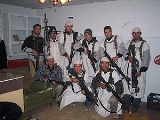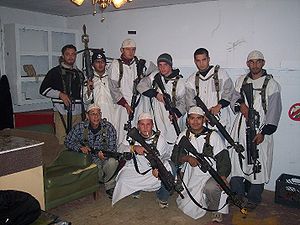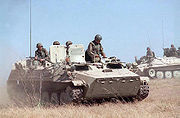
Opposing force
Encyclopedia

- The term opposing force is occasionally used to refer to a genuine military foe. This article is concerned only with its use in simulated conflict.
An opposing force (abbreviated OPFOR, used in the United States and Australia) or enemy force (used in Canada) is a military unit tasked with representing an enemy, usually for training purposes in war game scenarios. The related concept of aggressor squadron
Aggressor squadron
An aggressor squadron or adversary squadron is a squadron that is trained to act as an opposing force in military wargames. Aggressor squadrons use enemy tactics, techniques, and procedures to give a realistic simulation of air combat...
is used by some air forces.
At a basic level, a unit might serve as an opposing force for a single scenario, differing from its 'opponents' only in the objectives it is given. However, major armies commonly maintain specialized groups trained to accurately emulate real-life enemies, to provide a more realistic experience for their training opponents. (To avoid the diplomatic ramifications of naming a real nation as a likely enemy, training scenarios often use fictionalized versions with different names but similar military characteristics to the expected real-world foes.)
Opposing forces can also coincide with red team
Red Team
A red team is a group of penetration testers that assess the security of an organization, which is often unaware of the existence of the team or the exact assignment. Red teams provide a more realistic picture of the security readiness than exercises, role playing, or announced assessments...
ing activities. Once the Analytic Red Team develops adversary tactics, techniques, and procedures (TTPs) it will be the opposing force that makes use of those TTPs in wargames and exercises.
Some dedicated opposing forces may fight using the likely enemy's doctrine, weapons, and equipment. They may wear uniforms which resemble the likely enemy's, or one dissimilar to "friendly forces". Their vehicles may either be those operated by the likely enemy's, or may be modified to look like those. All these measures help to enhance training realism and provide useful lessons on how to fight this particular enemy.
Blank ammunition, smoke grenade
Smoke grenade
Smoke grenades are canister-type grenades used as ground-to-ground or ground-to-air signaling devices, target or landing zone marking devices, or as screening devices for unit movements. Smoke grenades are normally considered non-lethal, although incorrect use may cause death...
s, and artillery
Artillery
Originally applied to any group of infantry primarily armed with projectile weapons, artillery has over time become limited in meaning to refer only to those engines of war that operate by projection of munitions far beyond the range of effect of personal weapons...
simulators are often used by both sides in the exercise to provide the fog of war
Fog of war
The fog of war is a term used to describe the uncertainty in situation awareness experienced by participants in military operations. The term seeks to capture the uncertainty regarding own capability, adversary capability, and adversary intent during an engagement, operation, or campaign...
caused by the noise and smoke of battle.
In addition, a simulation system such as the Multiple Integrated Laser Engagement System
Multiple Integrated Laser Engagement System
The Multiple Integrated Laser Engagement System or MILES is used by the US military and other armed forces around the world for training purposes. It uses lasers and blank cartridges to simulate actual battle....
(MILES) may be used. This system is attached to various weapons, and are zeroed to the sights of the weapon. When a blank round is fired, the system sends out a laser beam, which score "kills" or "injuries" on any soldier or vehicle in what would be the path of the weapon's projectile. These laser beams are detected by receivers on harnesses worn by the soldiers, or on the vehicle itself.
Alternatively, paintball
Paintball
Paintball is a sport in which players compete, in teams or individually, to eliminate opponents by tagging them with capsules containing water soluble dye and gelatin shell outside propelled from a device called a paintball marker . Paintballs have a non-toxic, biodegradable, water soluble...
weapons which look like real weapons, or simulation rounds such as plastic bullet
Plastic bullet
A plastic bullet or plastic baton round is a non-lethal projectile fired from a specialised gun. Although designed as a non-lethal weapon they have still caused several deaths. They are generally used for riot control...
s may be used. Usually, controllers follow the training troops to help score additional kills, such as when a simulated grenade is thrown. They may do so with the MILES system using a controller gun. All these measures help to emphasize the importance of aimed fire, and taking cover. These concepts, while obvious, are often neglected in ordinary one-sided training exercises because the soldier does not suffer the consequences.
Units

United States
The United States of America is a federal constitutional republic comprising fifty states and a federal district...
' OPFOR. During the Cold War
Cold War
The Cold War was the continuing state from roughly 1946 to 1991 of political conflict, military tension, proxy wars, and economic competition between the Communist World—primarily the Soviet Union and its satellite states and allies—and the powers of the Western world, primarily the United States...
, opposing force units employed Soviet
Soviet Union
The Soviet Union , officially the Union of Soviet Socialist Republics , was a constitutionally socialist state that existed in Eurasia between 1922 and 1991....
military doctrine and simulated Soviet equipment; since the fall of the USSR, US opposing force units have become more flexible to represent a wider range of opponents. More recently training has focused on Iraq and Afghanistan.
There are three Major Training Centers that utilize home-based OPFOR units for the US Army:
- The National Training Center or NTC at Fort Irwin, California -- home unit is the 11th Armored Cavalry Regiment (the Blackhorse)
- The Joint Readiness Training Center or JRTC at Fort Polk, Louisiana -- home unit is the 1st Battalion, 509th Parachute Infantry Regiment (the Geronimos')'
- The Joint Multinational Readiness Center or JMRC (formerly known as the Combat Maneuver Training Center or CMTC) at Hohenfels, Germany -- home unit is the 1st Battalion, 4th Infantry Regiment (Separate) (the Warriors)
The units at NTC and JMRC were used to replicate a Soviet Motorized Rifle regiment or division. At NTC, M551 Sheridan
M551 Sheridan
The M551 Sheridan was a light tank developed by the United States and named after Civil War General Philip Sheridan. It was designed to be landed by parachute and to swim across rivers. It was armed with the technically advanced but troublesome M81/M81E1 152mm gun/launcher which fired conventional...
s were used to replicate Soviet T-80
T-80
The T-80 is a main battle tank designed and manufactured in the former Soviet Union. A development of the T-64, it entered service in 1976 and was the first production tank to be equipped with a gas turbine engine for main propulsion.the Swedish Stridsvagn 103 of 1971 used a gas turbine alongside...
tanks until 2003. Visually Modified
Vismod
The term vismod is an abbreviation of the term visually modified, and is used by the elements of the United States Department of Defense to refer to any vehicle, aircraft, or other object that has been altered to simulate equipment used by an enemy for training purposes, often by specialized units...
(VISMOD) HMMWVs are used to replicate BRDM-2
BRDM-2
The BRDM-2 is an amphibious armoured patrol car used by Russia and the former Soviet Union. It was also known under designations BTR-40PB, BTR-40P-2 and GAZ 41-08...
s, VISMOD M113A2s (known as the OPFOR Surrogate Vehicle [OSV]) are used to replicate BMP-2
BMP-2
The BMP-2 is a second-generation, amphibious infantry fighting vehicle introduced in the 1980s in the Soviet Union, following the BMP-1 of the 1960s....
Infantry Fighting Vehicles (IFV), while VISMOD M1 Abrams
M1 Abrams
The M1 Abrams is a third-generation main battle tank produced in the United States. It is named after General Creighton Abrams, former Army Chief of Staff and Commander of US military forces in Vietnam from 1968 to 1972. The M1 is a well armed, heavily armored, and highly mobile tank designed for...
Tanks (known as the Krasnovian Variant Tank [KVT]) and M113A2s (known as the OPFOR Surrogate Vehicle, Tank [OSV-T]) are also used to replicate the T-80
T-80
The T-80 is a main battle tank designed and manufactured in the former Soviet Union. A development of the T-64, it entered service in 1976 and was the first production tank to be equipped with a gas turbine engine for main propulsion.the Swedish Stridsvagn 103 of 1971 used a gas turbine alongside...
. At JMRC, M113A2s are used to replicate Soviet BMP-2s and M60A3 tanks are used to replicate Soviet T-80s.
During the mid-1990s, JMRC was used to train peacekeeping forces for the former Yugoslavia
Yugoslavia
Yugoslavia refers to three political entities that existed successively on the western part of the Balkans during most of the 20th century....
under low-intensity conflict missions. Currently, the OpFor mission has since been modified for counter-insurgency training for Operation Iraqi Freedom and Operation Enduring Freedom.
Starting in early 2004, NTC began focusing on training units selected to deploy to Iraq
Iraq
Iraq ; officially the Republic of Iraq is a country in Western Asia spanning most of the northwestern end of the Zagros mountain range, the eastern part of the Syrian Desert and the northern part of the Arabian Desert....
or Afghanistan
Afghanistan
Afghanistan , officially the Islamic Republic of Afghanistan, is a landlocked country located in the centre of Asia, forming South Asia, Central Asia and the Middle East. With a population of about 29 million, it has an area of , making it the 42nd most populous and 41st largest nation in the world...
in urban operations (UO). Towns of ever increasing size and complexity have been constructed throughout the training area to provide battlefield realism and housing for the hundreds of role-playing personnel, many of whom speak Arabic
Arabic language
Arabic is a name applied to the descendants of the Classical Arabic language of the 6th century AD, used most prominently in the Quran, the Islamic Holy Book...
or Kurdish
Kurdish language
Kurdish is a dialect continuum spoken by the Kurds in western Asia. It is part of the Iranian branch of the Indo-Iranian group of Indo-European languages....
natively, and replicate civilians On the battlefield while wearing Afghan or Iraqi clothing. Cultural awareness and liaison operations with local leaders are emphasized at all times and at all levels.
Various US military installations and/or major units have their own local versions of opposing force used for training exercises. The joint Australian/US military exercise "Crocodile '03" featured an Australian-led opposing force in which soldiers from a range of Australian units worked together with a US Marine Corps contingent.
The British Army
British Army
The British Army is the land warfare branch of Her Majesty's Armed Forces in the United Kingdom. It came into being with the unification of the Kingdom of England and Scotland into the Kingdom of Great Britain in 1707. The new British Army incorporated Regiments that had already existed in England...
rotates units through British Army Training Unit Suffield
British Army Training Unit Suffield
The British Army Training Unit Suffield is a British Army unit located at the vast training area of Canadian Forces Base Suffield in Alberta, Canada...
as OPFOR.
Further reading
- Validating the "Enemy" (discusses the USA's OPFOR units, and post-Cold War changes to OPFOR.)

